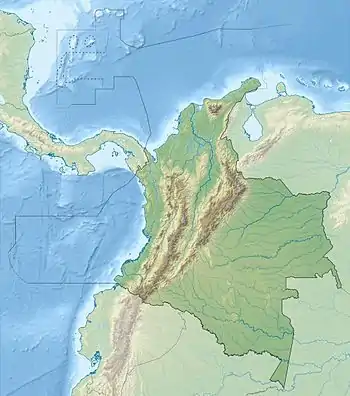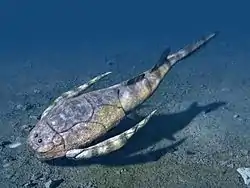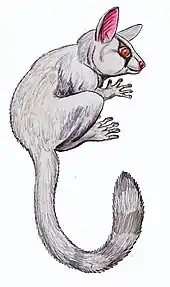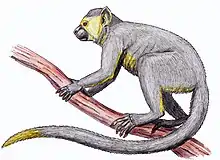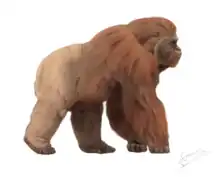| Patasola magdalenae | |
|---|---|
| Scientific classification | |
| Domain: | Eukaryota |
| Kingdom: | Animalia |
| Phylum: | Chordata |
| Class: | Mammalia |
| Order: | Primates |
| Suborder: | Haplorhini |
| Infraorder: | Simiiformes |
| Family: | Callitrichidae |
| Genus: | †Patasola Kay & Meldrum, 1997 |
| Species: | †P. magdalenae |
| Binomial name | |
| †Patasola magdalenae Kay & Meldrum, 1997 | |
Patasola is an extinct genus of New World monkeys from the Middle Miocene (Laventan in the South American land mammal ages; 13.8 to 11.8 Ma). Its remains have been found at the Konzentrat-Lagerstätte of La Venta in the Honda Group of Colombia. The type species is Patasola magdalenae.[1]
Etymology
Patasola magdalenae is named after the mythological Patasola ("one foot"), a forest spirit of the Gran Tolima region of Colombia. The species epithet refers to the Magdalena River in which valley the fossils were found.[2]
Description
Fossils of Patasola, a small insectivorous/frugivorous primate,[3] were discovered in both the La Victoria and Villavieja Formations above and below the "Monkey Beds" of the Honda Group, that has been dated to the Laventan, about 13.4 to 11.8 Ma.[4][5]
The type mandible of Patasola magdalenae is a juvenile specimen.[6] The estimated weight of Patasola was 480 grams (1.06 lb),[7] similar in size to the extant genus Leontopithecus.[8]
The genus is included in the Callitrichidae,[9] after an initial description as an intermediate between the Callitrichidae and Saimiri.[10]
Habitat
The Honda Group, and more precisely the "Monkey Beds", are the richest site for fossil primates in South America.[11] It has been argued that the monkeys of the Honda Group were living in habitat that was in contact with the Amazon and Orinoco Basins, and that La Venta itself was probably seasonally dry forest.[12] The authors of the publication about Patasola however suggests the presence of rain forest.[3]
See also
References
- ↑ Patasola magdalenae in the Paleobiology Database
- ↑ Kay & Meldrum, 1997, p.438
- 1 2 Kay & Meldrum, 1997, p.458
- ↑ Kay & Meldrum, 1997, p.437
- ↑ Wheeler, 2010, p.133
- ↑ Kay & Meldrum, 1997, p.440
- ↑ Silvestro, 2017, p.14
- ↑ Defler, 2004, p.32
- ↑ Takai et al., 2001, p.290
- ↑ Tejedor, 2013, p.29
- ↑ Rosenberger & Hartwig, 2001, p.3
- ↑ Lynch Alfaro et al., 2015, p.520
Bibliography
- Defler, Thomas. 2004. Historia natural de los primates colombianos, 1–613. Universidad Nacional de Colombia. Accessed 2017-09-24.
- Kay, Richard F., and D. Jeffrey Meldrum. 1997. The Miocene Fauna of La Venta, Colombia - A new small platyrrhine from the Miocene of Colombia and the phyletic position of the callitrichines, 435–458. Smithsonian Institution Press. Accessed 2017-09-24.
- Lynch Alfaro, Jessica W.; Liliana Cortés Ortiz; Anthony Di Fiore, and Jean P. Boubli. 2015. Special issue: Comparative biogeography of Neotropical primates. Molecular Phylogenetics and Evolution 82. 518–529. Accessed 2017-09-24.
- Rosenberger, Alfred L., and Walter Carl Hartwig. 2001. New World Monkeys. Encyclopedia of Life Sciences _. 1–4. Accessed 2017-09-24.
- Silvestro, Daniele; Marcelo F. Tejedor; Martha L. Serrano Serrano; Oriane Loiseau; Victor Rossier; Jonathan Rolland; Alexander Zizka; Alexandre Antonelli, and Nicolas Salamin. 2017. Evolutionary history of New World monkeys revealed by molecular and fossil data. BioRxiv _. 1–32. Accessed 2017-09-24.
- Takai, Masanaru; Federico Anaya; Hisashi Suzuki; Nobuo Shigehara, and Takeshi Setoguchi. 2001. A New Platyrrhine from the Middle Miocene of La Venta, Colombia, and the Phyletic Position of Callicebinae. Anthropological Science, Tokyo 109.4. 289–307. Accessed 2017-09-24.
- Tejedor, Marcelo F. 2013. Sistemática, evolución y paleobiogeografía de los primates Platyrrhini. Revista del Museo de La Plata 20. 20–39. Accessed 2017-09-24.
- Wheeler, Brandon. 2010. Community ecology of the Middle Miocene primates of La Venta, Colombia: the relationship between ecological diversity, divergence time, and phylogenetic richness. Primates 51.2. 131–138. Accessed 2017-09-24.
Further reading
- Fleagle, John G., and Alfred L. Rosenberger. 2013. The Platyrrhine Fossil Record, 1–256. Elsevier ISBN 9781483267074. Accessed 2017-10-21.
- Hartwig, W.C., and D.J. Meldrum. 2002. The Primate Fossil Record - Miocene platyrrhines of the northern Neotropics, 175–188. Cambridge University Press, ISBN 978-0-521-08141-2. Accessed 2017-09-24.
